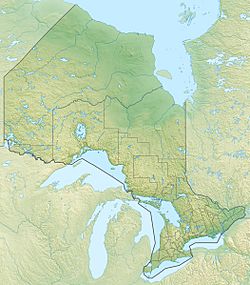Grass Lake (Haliburton County) facts for kids
Quick facts for kids Grass Lake |
|
|---|---|
| Location | Haliburton County, Ontario |
| Coordinates | 45°02′28″N 78°32′10″W / 45.041°N 78.536°W |
| Type | Glacial lake |
| Primary inflows | Drag River |
| Primary outflows | Burnt River |
| Basin countries | Canada |
| Frozen | Mid-December to Late April |
Grass Lake is a beautiful lake located in Haliburton County, Ontario, Canada. This area is often called "cottage country" because many families have vacation homes, or cottages, along the lake's shores. It's a popular spot for summer fun!
Grass Lake is part of a cool chain of five lakes. It connects to Head Lake on its eastern side and Kashagawigamog Lake to its west. Think of Grass Lake as a wider part of the Drag River. This river starts at Drag Lake, flows into Head Lake, moves through the chain of lakes, and then exits at Canning Lake. A special dam at Canning Lake helps control the water flow, and it's managed by the Trent–Severn Waterway.
Contents
Life in Grass Lake: Plants and Animals
Grass Lake is home to many different kinds of plants and animals. These living things create a healthy ecosystem, which is like a big community where everything works together.
Underwater Plants: Important Habitats
A study from 2015 found that most properties around Grass Lake had lots of plants growing underwater. These are called submergent plants. They are super important because they provide shelter and food for fish and other creatures that live in the water.
Plants Above Water: Emergent Vegetation
The study also found many emergent plants. These are plants that grow in the water but stick out above the surface. They are a great place for fish and other aquatic animals to hide and find food.
Floating Plants and Wildlife
While less common, floating vegetation is also a key part of the lake's ecosystem. These plants float on the water's surface. They offer important habitats for birds, frogs, dragonflies, and other wildlife. Imagine a frog sitting on a lily pad!
Nearshore Habitats: Logs and Overhanging Plants
The areas right next to the shore are also very important for wildlife. The most common types of natural habitats found near the shores of Grass Lake include fallen logs and plants that hang over the water. These spots provide shelter and hunting grounds for many animals. Most properties around Grass Lake have some of these natural habitats, which is great for keeping the lake healthy and full of life!


